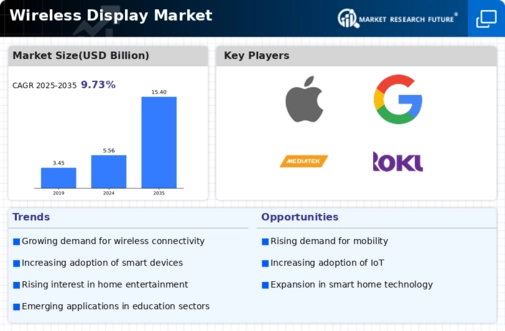Top Industry Leaders in the Wireless Display Market

Competitive Landscape of Wireless Display Market
The wireless display market is a dynamic and increasingly competitive space. Driven by consumer demand for convenience, mobility, and seamless content sharing, wireless display technologies are revolutionizing how we view and interact with information. Understanding the competitive landscape is crucial for both established players and new entrants aiming to thrive in this burgeoning market.
Some of the Wireless Display companies listed below:
- Apple Inc.
- Google LLC
- Intel Corporation
- Marvell Semiconductor Group Ltd.
-
MediaTek Inc. - Roku Inc
Strategies Adopted by Key Players:
- Innovation and R&D: Continuous investment in research and development fuels technological advancements, leading to lower latency, increased bandwidth, and improved user experience.
- Strategic Partnerships and Collaborations: Collaborations with technology leaders, device manufacturers, and content providers expand market reach, improve compatibility, and enrich user experience.
- Focus on User Experience and Ease of Use: Intuitive interfaces, seamless pairing, and plug-and-play functionality are crucial for user adoption and differentiation in a crowded market.
- Cost-Competitive Strategies: Offering affordable entry-level solutions alongside premium offerings caters to diverse budget constraints and expands customer base.
Factors for Market Share Analysis:
- Technology Standard: Diverse protocols like Miracast, AirPlay, and WirelessHD compete for dominance, influencing device compatibility and market adoption. Analyzing standard adoption across segments is crucial for understanding market dynamics.
- Target Audience: The market caters to various segments, from home entertainment enthusiasts and remote workers to educational institutions and corporate conference rooms. Identifying specific needs and preferred technologies within each segment is vital for targeted product development.
- Hardware Integration: While dongles and adapters dominate the market, smart TVs and projectors with built-in wireless display capabilities are gaining traction. Understanding the shift towards integrated solutions is crucial for strategic investment.
- Regional Landscape: While North America and Europe currently hold the lead, Asia Pacific is experiencing rapid growth due to the rising consumer electronics market. Analyzing regional trends and regulations is essential for global expansion strategies.
New and Emerging Companies:
- Startups Focusing on Applications: Companies cater to specific segments like gamers and educators with specialized features and software functionalities.
- Software-Based Solutions: Companies like develop software that enables wireless display functionality on existing hardware, offering cost-effective alternatives.
- Open-Source Initiatives: Open-source projects like Raspberry Pi's Miracast implementation allow for customization and affordability, potentially disrupting the proprietary technology landscape.
Latest Company Updates:
Apple Inc.:
- October 27, 2023: Announced plans to integrate AirPlay 3 with new smart TV models from LG and Samsung, expanding compatibility and reach beyond Apple devices.
- June 14, 2023: Unveiled updates to the AirPlay framework at WWDC 2023, featuring improved latency and multi-device streaming capabilities, potentially enhancing the user experience.
Google LLC:
- December 5, 2023: Revealed the next generation of Chromecast dongle with built-in Google TV, featuring improved Wi-Fi 6 capabilities for smoother wireless display streaming.
- September 20, 2023: Announced updates to the Cast API, including support for higher resolutions and HDR content, paving the way for improved wireless display quality.
